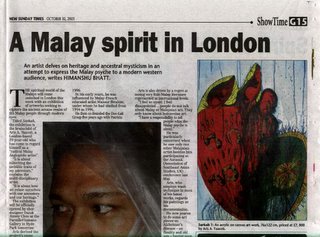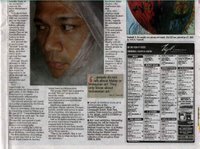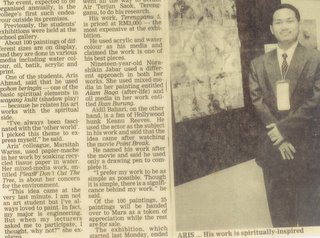12.22.2007
11.06.2007
Lobbying The New Body of Work of Aris A Yaacob
 Left to right: Rozita Md (Novas Curator), Aris A Yaacob (the artist)
Left to right: Rozita Md (Novas Curator), Aris A Yaacob (the artist) & Erwina AGhafar (Head Curator of Novas)
go to www.novas.org/contemporary-urban-centres/
 Aris A Yaacob (visual interpretation of wayang kulit) copyright 2007
Aris A Yaacob (visual interpretation of wayang kulit) copyright 2007
An event at Liverpool Novas Contemporary Urban Centres in 2009, the capital culture of Europe. A new body of work by Aris A Yaacob, High Priest: The Songs of Destruction.
This exhibition is a quest. Questioning the significant of the High Priest in relation to society – how one group of people has been divided by the power of a man who some consider consecrated and some bigoted. He is not just an ordinary man, but a leader of men.
In wayang, a form of shadow puppet performance, the operator of the puppets is regarded as the High Priest who capable of surpassing human belief that the wayang is God. Thus, every word of the High Priest is a word of God, the truth and absolute. Somehow along the line, the audience is shadowed by the sacred power that the High Priest has secured. He is the God illegitimate child, invention of evilness, and deliberately disseminates poison through the religious songs for power and control.
According to Seneca the Younger, Religion is regarded by the common people as true, by the wise as false, and by the rulers as useful. An excellent analogy that we can look at as the High Priest uses religion to protect his own interest or magisterium or perhaps, purely for political and economic reasons. Hence, Napoleon once said, Religion is excellent stuff for keeping common people quiet.
For this six week exhibition in 2009, a collection of iconographic works will be exhibited, which include drawings, paintings and a reinterpretation version of wayang performance.
‘... to find strategy of meaningful social, political, and cultural positioning , arguably the most critical challenge confronting, contemporary art today,certainly, making sense the relationship of my practice – breaking the boundary of visual and performance art, freeing the space and separation’ Aris A Yaacob (the artist).
'It is time for wayang to be reread ' Erwina AGhafar (Head Curator of Novas)...
5.23.2007
Masterwork 2007 : PACI University of Leeds 17 - 19 May 2007
Aris A Yaacob @ Masterwork 2007
www.leeds.ac.uk/paci/masterworks/artists_yaacob.html
2.26.2007
Aris A Yaacob: The winner of Doctorate Scholarship in Performance & Technology from University of Leeds, February 2007
11.03.2006
SOLD - Sarkah: The Lines, for sale @ Nolias Gallery (Basement), Angel, 201 Liverpool Road, N1 1LX
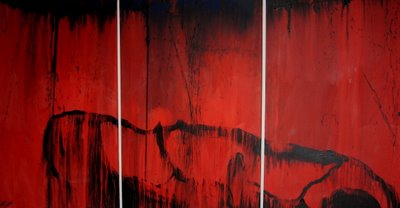
SOLD - Title: Sarkah - The Lines by Aris A Yaacob, Medium: Acrylic on Canvas, Dimension: 228x366 cm, Price: £3000 . For further info on the gallery, please go to www.noliasgallery.co.uk
Aris A Yaacob & Nolias Gallery


Aris with Nolia Devlin, the Gallery Director of Nolias Galleries Aris with Simon Lepp, the Curator of Nolias Gallery (Basement) Background painting is by the artist Stephen Riley, www.stephenrileyart.com
9.11.2006
A Quotation from Jay Jopling, White Cube

'..........really interesting and really striking' Jay Jopling and Cassie Hooper, White Cube www.whitecube.com
4.10.2006
Aris @ ZigfridUnderbelly London: REVIEW BY THE SUNDAY MAIL
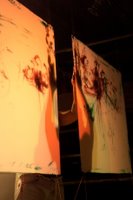
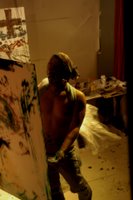
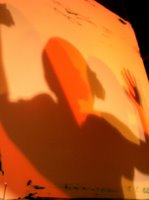
THE SUNDAY MAIL
16 April 2006
Written by Haliza Hashim-Doyle
Photos by Andy Craggs
At its most fundamental, Live Art is when an artist chooses to make his work directly in front of the audience in a particular space and time. Many artists have left the galleries and seek more public and specific sites to showcase their work. London itself has become a gallery. Live art tends to involve the unexpected. It may have elements in common with performance arts such as drama or dance, but it moves beyond the conventions and the usual boundaries. Some live artists use shock tactics to draw the audience - fighting in the street; suspending oneself from the side of a tower block; or holding a steady pose for hours at a time. Other live art simply involves hours of high-energy work producing spontaneous and vibrant paintings. Moving beyond the conventions and the usual boundaries is what Aris Ahmad Yaacob, a self-declared radical Malay Anglophile artist, hopes to achieve. The 29-year-old who hailed from Seremban, Negri Sembilan intends to `modernise the traditional understanding of certain genres in Malaysian art'.
Held at a trendy club in London, Aris faced the audience through two frosted perspex blocks to perform a shadow-figure-like performance onstage while painting. He moved sinuously with the music using his palms, fingers and a length of plastic attached to his body to paint. "I love painting and I love performing, so I combine the two. My ideology, my way of documentation of the moment is more important than just a final result. The audience at the show will appreciate the painting sentiment. It is personal and meaningful." Bare chested, wearing a cloth mask and his trademark `plastic cape', Aris stressed that his bizarre outfit represented him. "The subject matter is puppetry. My appearance is irrelevant, in fact it added a visual impact to the performance." Asked if he was successful in interpreting wayang kulit in his live art show, Aris replied that there were mixed reactions from the audience. Most loved the performance, some disagree with the paintings while others said the paintings are insignificant compared to the concept and ideas. He said: "My idea was to challenge the existence of wayang kulit. Usually it is performed in days but I presented it in 20 minutes. Wayang kulit puppets are ready-made but I made my puppet using the plastic on stage. I documented the narrative via painting instead of a moral story. Finally, my interpretation of wayang kulit is for the contemporary audience, you either like it or hate it." He reiterated that: "To me, criticisms and comments of my work can only mean that my work is being noticed and talked about!" Aris has held a number of exhibitions in Britain for the last 12 months including a modern interpretation puppetry performance at a conference on Southeast Asian Studies held at the University of Exeter, and solo art work exhibitions at the Farmilo Fiumano Gallery and Nolias Gallery in London. The Malaysian High Commission Office, The Malaysian Tourism Promotion Board and shoe designer, Datuk Jimmy Choo, are among Aris's supporters in London.
Aris went to Britain in 1996 to study architecture in Manchester. Knowing that his interests and talents leaned more towards art, he then did a Masters degree in Scenography (time-based art namely puppetry) at Wimbledon School of Art, London. Not surprisingly, Aris who is very much inspired by wayang kulit and expressionism, is currently writing a dissertation on wayang kulit and puppetry. When asked if an artist needs to redefine the role and concept of paintings in order to be recognised, Aris said: "I have no pressure, I do it for passion. I do not redefine the role and concept of my paintings but instead I challenge myself." Aris, who is planning another exhibition for a much bigger audience, admitted that: "To put on an exhibition in London, especially as a young, struggling artist - no matter where you're from, even if you're British. Passion, will power and determination can only bring you so far. There is no easy way because there are many artists in London. You have to persevere if you want to be the next Picasso."
Photos by Andy Craggs www.andycraggs.com
Read ZigfridUnderbelly London exhibition review
http://www.malaysiakini.com/rentakini/48573
Read the review of Sarkah Exhibition in Mayfair, London
http://www.malaysiakini.com/rentakini/43033
3.05.2006
Aris A Yaacob @ ZIGFRID Underbelly LONDON

Aris A Yaacob in a Mask, 2006
Live Art: The World Is A Stone @ Zigfrid Underbelly Bar-Club on the 9 March 2005 at 7.3opm - late, in which Aris A Yaacob will be performing an interpretation of wayang kulit in collaboration with an established Dj from Introspective London; performing the ritual of shadow puppet and unfolding the story based on the music composed by Dj Charles via painting on perspex. The audience will visually experience a shadow-figure like performance on stage and experience the painting manifested by the artist during the performance. Go to www.underbellylondon.com and click on The World Is A Stone for tickets. Exhibition sponsored by Flukes and curated by Masuda Tomohiro.
12.02.2005
Hot Gossip Magazine: What the Editor Says about Aris?
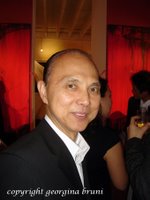
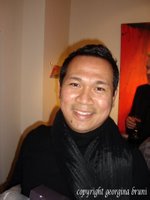
'Talking of launch parties, I attended a very unusual art showing at FarmiloFiumano Gallery, where Malay Anglophile artist ARIS A YACOOB entertained with a version of puppetry that seemed to be very futuristic. The show also included art and paintings from his 'Sarkah' range. One of his supporters is internationally acclaimed shoe designer JIMMY CHOO, who I got to meet. I just adore his shoes….. FarmiloFiumano Gallery, 27 Connaught Street, London. .... Aris is on the left & Jimmy is on the right'..... Georgina Bruni, Editor of Hot Gossip Magazine, Dec 2005
Buy the music CD from the above exhibition from
www.onkong.com
12.01.2005
2004: Simulacra Review

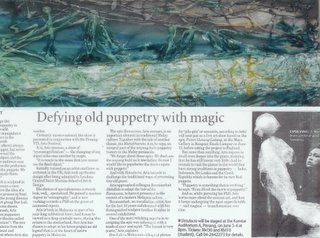 Keith Mills (Aris A Yaacob's patron), Sanela & Patrizia Adami (Photographer) Simulacra at Penang Arts Festival, review by New Straits Times, June 2004
Keith Mills (Aris A Yaacob's patron), Sanela & Patrizia Adami (Photographer) Simulacra at Penang Arts Festival, review by New Straits Times, June 2004
Read Simulacra review at ASEASUK Conference 2005 http://www.kakiseni.com/articles/reviews/MDY4OA.html
AAP online http://www.yavanika.org/aaponline/index.php?option=com_content&task=view&id=38&Itemid=2
Aseasuk webpage http://mercury.soas.ac.uk/aseasuk/
11.29.2005
Sarkah: Live Art-The Cave in triptych
 Aris A Yaacob is Radical Malay Anglophile Artist.
Aris A Yaacob is Radical Malay Anglophile Artist.His ideology on art is about documenting the process of live art via painting and drawing. Paradoxically, he radicalises the Malay art of Wayang Kulit. He uses Perspex and plastic to recreate the puppets and obsessively deals with the subject matter about GODS.
(Pic) Live Art-The Cave: Sarkah in Triptych. (The performance is in between of the two paintings)
11.28.2005
Aris A Yaacob: Contact Detail & List of Exhibitions
 (Sarkah: Pencil drawing on acid-free paper, A3 size, £400, courtesy of Aris A Yaacob)
(Sarkah: Pencil drawing on acid-free paper, A3 size, £400, courtesy of Aris A Yaacob)ARIS A YAACOB
PCI Leeds University LS2 9JT Leeds
Mobile: 07789528421
e-mail: ariscurator@yahoo.co.uk
PROFILE
PhD Scholar: Leeds University 2007 – Date
MA Scenography: Wimbledon School of Art London 2002
Pg.Cert Scenography: Central St. Martins School of Art & Design London 2000
BA Architecture: Manchester School of Architecture
Int. Baccalaureate: IB Centre Malaysia 1996
Further Education Teaching Certificate, International House
CAREER HIGHLIGHTS AND ACHIEVEMENTS
Selected Events & Exhibitions
.The World Is A Stone, ZigfridUnderbelly London 9 March 2006
· Rebranding Malaysian Art, Nolias Gallery London 14 – 20Nov05
· Sarkah , FarmiloFiumano Gallery London 31Oct– 6Nov05
· Retrospective 05, MHC 45 Belgrave Square London 8 Sept 05
· BOC Emerging Artist Award UK, Finalist (50) Aug 05
· Studio Voltaire London, Annual Exhibition / Member July 05
· ASEASUK, Live Art, Exeter UK May 05
· ASEASUK, Paper presenter, Exeter University May 05
· Unfolding, Moving Gallery Exhibition, Zouk Club KL Dec 04
· KL August Festival, Live Art, BB Park KL Aug 04
· Malaysian Theatre Festival, Performance, Malaysia Aug 04
· Princess Ledang, Live Art / Sculpture, Maya Gallery KL July 04
· Penang Arts Festival, Live Art, Penang June 04
· Simulacra, Live Art, National Art Gallery Malaysia Apr 04
· Object Animation, Talk, National Art Gallery KL Apr 04
· Simulacra, Live Art, WSA Theatre London Oct 02
· Sand Glass Theatre California, Puppetry Workshop 2001
· Twin Brother, Design/Direction, WSA Theatre London Jan 01
· BAC-Puppet Centre London, Children Puppetry Workshop 2001
· Of Men & Other Familiar Strangers, Production Design, TAS KL Sept 00
· Obake, Performance, Hoxton Hall London Feb 00
· Lady from The Sea, Scenography, Drill Hall Theatre London Nov 1999
· Fish & Ship, Time Based Art Exhibition, CSM London Dec 1999
· Performing Object, Workshop with Theodora Skipitares 1999
· Queer Up North Festival, Dance, Greenroom Manchester Oct 1998
· MARA KL, Batik - Public Exhibition 1996
· FEWW Exhibition: Putra World Trade Centre KL, Malaysia Jan 1996
· IB, Diploma Exhibition, IB Centre Malaysia Apr 1996
· IB, Art Exhibition, IB Centre Malaysia 1995
· Comparative Literature, Paper Presenter, DBP KL Malaysia June 1995
AWARDS & COMMISSIONS
· Bluequadrant Design London, Sarkah Exhibition 2005
· Bluequadrant Design London, Live Art, ASEASUK 2005
· World Travel Market & Tourism Malaysia, Rebranding Malaysian Art 2005
· Malaysian High Comm. London, Retrospective 05 2005
· YTL Corporation, Live Art, Penang Art Festival 2004
· Sara Shah @ PETRONAS, Painting 2004
· Zouk Club Comm., Painting, Sclupture & Live Art 2004
· Malaysian Theatre Society, Performance 2004
· DBKL/ KL Council, Live Art, KL August Festival 2004
· MARA Scholarship, 3 years, BA in Architecture 96-99
· MARA Scholarship, 2 years, IB Diploma (Art & Design) 94-96
· MARA Scholarship, 2 years, O-Level 92-93
PROFESSIONAL MEMBERSHIP
· ATL – Member of Association of Teachers & Lecturers
· UNIMA – Member of British Puppetry UNIMA
· Studio Voltaire London – Member/ External Resident Artist
ARTICLES
Sunday Mail, Aris A Yaacob - Live Art, 16 April 2006
Malaysiakini.com, Live Art In London, March 06
New Sunday Times, A Malay Spirit in London, 31 Oct 05
Malaysiakini.com, Sarkah Exhibition Review, 15 Oct 05
www.kakiseni.com, Abducted Traditions, 21 June 2005
www.kakiseni.com, Unfolding, 1-5 Dec 2004
KLUE Magazine, Unfolding, issue Dec 2004
Juice Magazine, Unfolding, issue Dec 2004
Berita Harian, Seni Interaktif di Klub Zouk,2 Dec 2004
New Straits Times Malaysia, Defying Old Puppetry with Magic, 30 May 2004
www.kakiseni.com, Simulacra @ Penang Arts Festival, issue June 2004
New Straits Time Malaysia, FEWW Exhibition, 18 Jan 1996
Berita Harian, FEWW Exhibition, 16 Jan 1996
LIST OF PUBLICATION
Aris A Yaacob, ‘Malay Paradox: Rereading Mystical Life of Ramayana Epic’; ASEASUK Conference, Exeter, May 2005.
Rozmanshah Abdullah & Aris A Yaacob, Simulacra, Badan Teater Selangor Shah Alam, July 2004.
Aris A Yaacob, ‘Comparative Study: Malay and African Literature in IB Curriculum’; Comparative Literature Seminar Bulletin, DBP Kuala Lumpur, July 1995.
EMPLOYMENT
· Artistic Director, Doo-Lali Group KL/ London/ Zurich Jan 00 -Date
· Director arisNman, KL Dec 04 -Date
.Teacher in Art, Drama & English, Matthew Arnold School, Dec 04 - Date
· Programme Leader in Visual & Performing Arts, LimKokWing University
Malaysia Dec 03 - Dec 04
· Lecturer Part Time in Puppetry/Stagecraft/Production, University of Institute Technology
Mara Malaysia Dec 03 -Dec 04
· Teacher in Art, Drama & English, Matthew Arnold School Staines UK Jan 02- Dec 03
· Teacher in Art and Drama, Christ College Guildford UK Jan 01 - Dec 01
· Asst. Theatre Manager, The Actors Studio Mar 00 -Nov 00
· English Lecturer P/T, University Technology Malaysia 2000
· Set Designer P/T, River Grass Theatre 2000
PATRON
Keith W Mills (DipArch/RIBA/AIQA/MIPS)
Principal of Bluequadrant Design
Jimmy Choo OBE
COLLECTORS/SUPPORTERS
Bluequadrant Design United Kingdom
Jimmy Choo OBE
Ministry Of Arts, Heritage & Culture Malaysia
National Art Gallery Malaysia
Urban-Life Magazine London
MHC London
Dr Nick Till
Patrizia Adami Sutter, Switzerland
ASEASUK, United Kingdom
Sara Shah @ Petronas
Editor of Kakiseni Online Arts Magazine
YTL, Penang Arts Festival
Jennifer Stirrat, New Zealand
World Trade Centre (PWTC), Malaysia
Wimbledon School of Art
Mansor Ibrahim @ The French Institute
Dr Matthew Cohen
Limkokwing University College of Technology
Studio Voltaire London
ZOUK Club KL
Haliza Hashim-Doyle
Doo-Lali London
Doo-Lali Malaysia
Man @ RAGallery
Royal Holloway University of London
The Royal Family of Malaysia
MARA Headquarters, Kuala Lumpur
Kuala Lumpur City Council
International Baccalaureate MARA College
RTM – Malaysian Television and Radio Broadcasting
The Association of Malaysian Theatre Festival
E A Mills
MAYA Gallery
Kampung Warisan KL
Jemari
arisNman
Tourism Malaysia
11.27.2005
Sarkah 2005 Articles: By Elizabeth Ann-Colville & Malaysiakini.com Magazine

Sarkah: Paintings on Perspex, for further info on the paintings please write to ariscurator@yahoo.co.uk
Malay Spirits in London
ARIS A YAACOB EXHIBITION
Written by Elizabeth Ann-Colville
On the evening of the 3rd November the large first room of the FarmiloFiumano Gallery near London’s Hyde Park was packed full as Jimmy Choo OBE introduced Aris A Yaacob who since his first exhibition at the Putra World Trade Centre Kuala Lumpur in 1996 has gained an international reputation. He is a prolific and original artist interpreting his inner self as created by his ancestral spirits in exquisite monochrome drawings then developed into vivid acrylic paintings. Having read the Koran from a young age he has used his familiarity with Arabic (Jawi) calligraphy and taking the word malam meaning night the time of spirits, has worked this form into a series of flowing patterns in powerful colours. On exhibition was work developed from 1999 but prepared in the last 12 months consisting of 70 drawings, 12 paintings and 9 perspex overlayed paintings combined with lettering patterns.
It is said that more Britons now believe that spirits exist than believe that there is a God. A belief in the supernatural and the questioning of life after death has haunted humanity from the most primitive to ultra sophisticated and is the basis of most religions.
Communication with the spirit world is celebrated around the globe: Yu Lan (Cantonese for Festival of Hungry Ghosts) and in Japan Obon when ancestors visit their living families. America and Ireland revert to pre All Hollow’s Eve – the Eve of all Saints’ Day. In Celtic times New Year began in November 1st and on Samahin, the night before, ghosts of the dead were thought to return to earth. In Spain, Mexico and much of Latin America into the 21st century on November 2nd El Dia De Los Muertos (The Day of the Dead) is till celebrated with picnics at graves and shrines at home with replicas of object which pleases the departed in their lives on earth.
In Malay SAKA (Anglicised phonetically to Sarkah) is the ancestral spirits with which one is born influencing one towards anger such as the aggressive wild animals or tranquillity found in flowers and peaceful images. Sarkah was the title of this exhibition. Either side of the door leading to the second of the three rooms were too large red panels entitled ‘The Cave’ and in the space between Aris performed his interpretation of Wayang Kulit which in its original form is similar to Southeast Asian shadow puppets of heroes, demons, animals and clowns with performances which can last for many hours with the puppeteer moving the figures, singing and conducting the orchestra. Fifty years ago there were well over a hundred masters of this art but since the popularity of television as entertainment there are now thought to be less than half a dozen. The music on his occasion was provided by On-Kong and the movements inspired by a poem especially written by Rozmanshah Abdullah.
Enveloped in many layers of clear plastic the apparition brought to mind that man makes puppets portraying the shadow of man and full circle Aris A Yaacob is man portraying the puppet-shadows of spirits of mankind past and present. When he first appeared I was anxiously aware of the one word which has come into common use in English from Malay – Amok; not the marshal tactic used in warfare but the solitary pengamok (amok runner) referred to by Centi from the early 15th Century. Men possessed possibly by religion, drugs or deep grief who would attack everyone in sight even to death ……but to my great relief Aris used calm and graceful movements and like the artwork on the walls one did not need to understand the spiritual meaning in order to enjoy and appreciate it.
Of every work sold that evening 5% was given to the children of Niger. I noted that the two panels of ‘The Cave’ between which Aris performed were separately priced and wondered how much the triptych would cost but sadly I doubt it would be available!
A wider exhibition of his work ‘Rebranding Malaysian Arts’ and a repeat performance of ‘Reinventing Puppetry’ at the Nolias Gallery near the Tate Modern in SW London is to be attended by the Tourism Minister of Malaysia on the 15 November during the four day World Travel Market at which over five and half thousands of the world’s leading travel and tourism companies from over 190 countries will be competing for their share of the international tourist trade. Aris A Yaacob exhibition mean that visitors can buy his work to have at home and be inspired to visit the country of its origin.
There is more information on Aris A Yaacob and his unique work and the poems of Sarkah if you contact Rozmanshah Abdullah via ariscurator@yahoo.co.uk
or rozmanshahabdullah@yahoo.co.uk
------------------------------------------------------------------------------------------------
Elizabeth Ann-Colville London born of English mother and French father. Worked on Britain daily and national papers and magazines then went freelance as writer and photographer. Fairly well travelled but not yet to Malaysia! Now post official retirement age but last year abseiled 160 feet (14 stories) down local hospital building to raise funds for Marie Curie Cancer Care.
Elizabeth Ann-Colville (Journalist/photographer/photo library/PR Consultant)
MALAYSIAKINI.COM MAGAZINE
A Malaysian artist in London
Farah Fahmy
Nov 15, 05 , 2:15pm
Last week, a corner of London's fashionable W2 area became brighter thanks to an exhibition by a Malaysian artist. Sarkah, Aris Yaacob's debut solo exhibition was held at the FarmiloFiumano Gallery and its opening night was attended by many guests, including acclaimed shoe-maker Jimmy Choo and the Malaysian High Commissioner to London. Sarkah celebrates the Malay psyche and the artwork is visually arresting. Aris uses bold strokes and vibrant colours in his work. "Sarkah is based on the word saka," he explained. "The word pusaka is more about materials whereas saka is spiritual, it's deeper and has got more depth to it. We should consider wayang kulit as saka for example. I'm exploring this idea because I think it's so interesting". Alongside his close friend and collaborator Rozmanshah Abdullah, Aris had been working on the idea and concept behind Sarkah for a long time.
The Malay psycheHe has always been interested in Malay psyche, and his explorations in the subject are done in the Malaysian context. This is after all, what he can relate to the most: "You can be Malay no matter where you are, no matter what citizen you are but I was born in Malaysia, raised in Malaysia; your early childhood in Malaysia, that is something you cannot take away from your own destiny, your own fate because the early childhood, that's what makes you who you are." Being abroad has made Aris become even more aware of his identity as a Malaysian Malay. At a conference on South-East Asian Studies held at the University of Exeter recently, Aris was disappointed to note that whilst there were hardly any talks on Malay psyche, art or literature, talks on Indonesian art were held. Indonesian art and culture was dominant, leaving Aris feeling as though Malay arts and culture from Malaysia was very much the junior partner. He accepts that there is a similarity between the (Malaysian) Malay and Indonesian arts, but feels that "... there's a major distinctive line that you can draw to divide the two". "When you talk about wayang kulit (shadow puppets) they always talk about Java, when you talk about batik they talk about Indonesia, gamelan Indonesia. Where is Malaysia?" he ponders. Aris, who hails from Seremban, has been living in London for almost ten years.
As a young child, he knew he was creative: "When I was small, I always loved to draw and I entered a lot of art competitions". He also had a great interest in the arts, but the education system made it difficult for him to pursue his interest ("You don't have the chance to learn literature"), although he did manage to study with French-trained Malaysian artist Mansor Ibrahim, whose influence he acknowledges, during his two-year International Baccalaureate course. He eventually gained a degree in architecture, but on its completion, Aris realised that his interest did not lie in the architectural world, and he pursued a Master's degree in Theatre Design. Being close to the creative and arts world again brought to the fore his first love of drawing and "... that's how it all began". Already a rising star in the Malaysian arts scene, nevertheless Aris admits that life as an artist is not easy, and he is thankful for the support and patronage that he has enjoyed so far. "To put on an exhibition in London, especially as a young, struggling artist - no matter where you're from, even if you're British - passion, will, and determination can only bring you so far. There's no easy way. There are too many artists in London".
Network, network, networkHe continues: "You have to be persistent and I think it's all about communication. You need funding and support from established organisations, institutions or even individuals. In a way it's all about contacts, marketing, PR, that's what you have to do to progress." Aris's supporters include his business partner Keith Mills, the National Art Gallery in Malaysia, the Malaysian High Commission in London, and Studio Voltaire London. How did he manage to gain such strong support? Aris laughs. "I can't tell you that!" He admits later that it was all down to "networking and meeting the right people at the right time". Jimmy Choo, for example, has a shop almost directly opposite the FarmiloFiumano Gallery. Aris is currently completing a Ph.D in re-reading and re-interpreting wayang kulit and plans to become a full-time artist when he graduates. He wants to do more exhibitions, not just in London but also in Malaysia. His intentions are plain - to challenge the perception of Malay art in London so as to give greater exposure to works from Malaysia, and to challenge the Malaysian perception of art in Malaysia. His reinterpretation of a wayang kulit show in Malaysia last year was not universally liked. "People hated my work; they said it was rubbish and I even had a comment saying my work was childish," he admits. Not that this would stop him - Aris, a self-declared radical Malay artist, intends to "contemporise the traditional understanding of certain genres in Malaysian art". Having held a lecturing stint at the LimKokWing Institute in KL, Aris would not mind teaching again. "I love teaching. Although it's not something I want to do fulltime it's very self-satisfying to share your knowledge with others and then learn from others".
Once established, Aris would also like to support young Malaysian artists and become a patron of Malaysian art. He cheekily and cheerily adds, "Tell the Ministry of Culture to give me some funding so that I can open a gallery to support Malaysian art in London". His ultimate ambition though, is to be the next big Malaysian "thing" worldwide. "I'd love to become the Malaysian Picasso," he declares, "why not? After all, if Jimmy Choo can do it, why can't I?" Note: Aris's next exhibition is on the 15th of November, at the Nolias Gallery in London, and Aris can be contacted via his email address: ariscurator@yahoo.co.uk.
------------------------------------------------------------------------------------------------
FARAH FAHMY is a regular contributor to malaysiakini. She lives in London.
11.26.2005
Aris A Yaacob (Founder of Doo-Lali Group): The Profile & History
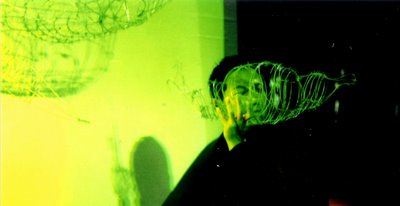
(The picture above is taken on 2004 YTL-Penang Arts Festival, Simulacra, performed and designed by Aris A Yaacob)
Doo-Lali Group:
Founded by Aris A Yaacob,
Rozmanshah Abdullah &
Patrizia Adami Suter
The Malay Paradox:
Rereading the mythical life of the Ramayana epic.
(Featuring an animated object performance, ‘Simulacra’.)
Venue: Exeter University in conjunction with ASEASUK Conference
Date: May 2005
A paper presentation prepared by:
Aris A Yaacob
Rozmanshah Abdullah.
Performed by:
Patrizia Adami Suter
Edited by:
Penny Francis (MBE)
Abstract
In this study, we define a new concept of puppetry as ‘A new visual aesthetics of an object in parallel to constructive method of manipulation in a setting derived from the conceptual and visual interpretations. Concept refers to the general idea of source or notion which we classify in two categories as real or unconscious which generate the visual outcomes of the research’
For this study, we take into account the mythical characters of the Ramayana epic (termed as the Epic) with particular emphasis on the main characters: Soorpanaka, Ravana, Sita and Rama. In general, myths and legends are collections of stories by which we explain our beliefs and history. Myths usually confront major issues such as the origin of humanity and its traditions where more often than not myths grant continuity and stability to a culture.
The epic, which originates from the Indian Region and without certain knowledge of its authorship, has become a communality of tales throughout Asia simply because of its universal themes. However, this epic as it was handed from one generation to another became attuned to each whatever community that embraces it and here is our starting point. Of studying the Malay Paradox and reinterpreting it hence rereading the mythical life existentiality of the epic through our animated objects performance of Simulacra.
In essence, myths present guidelines for living. When myths tell about the activities and attitudes of the deities, the moral tone implies society’s expectations for our own behaviour and standards. In myths, we learn and see the archetypal situations and some of the options which can be selected in those situations there for us to apply.
From our own experience in performing, the most fulfilling and satisfactory moment for us is when our conscious mind is provoking an audience and narrating a story, which elevates life to a new dimension, away from the world of reality. This is the concept which we could personally relate to ourselves, to the existence of subconscious forms of life.
‘Simulacra’ is a Doo-Lali group performance, which inquires ‘How puppetry does mutate from one form to another?’. To investigate the evolution of puppetry; animating the inanimate object material.
We have always believed and adopted this idea in our work but were not really certain of its meaning until we read the book Chaos, Creativity and Cosmic Consciousness by Rupert Sheldrake[1], Terence McKenna and Ralph Abraham. Sheldrake stated that ‘There is a present moment, so there is a past and a future, and the window of the present is moving along the time wave[2]. Along the way, the future is being created by the emergence of forms of increasing complexity and increasing integrity. There is another level below, at the bottom of the figure, which I am calling chaos, or the Gaian unconscious. This contains not form but the source of form, the form of form, the material that form is made of.’
In this research, our tools are inspired by the idea above, involving the complexity and integrity of the two worlds. However, our Gaian world is interpreted as the spiritual unconscious which derives from our understanding of The Al-Quran interpretation of forms. In the holy book, it stated that, ‘Man is made of mud, jinn and satan are made of fire and angel is made of light’.
However, this interpretation does not finish here because it is a complex matter which involves the issues of ‘How we feel and relate to the form?’ and ‘How we react to the essence of form?’ . These two issues are very significant to the history of mankind and whether we realise it or not they have subjugated human nature since the first human being, Adam.
So, the statements and debates above which derive from the sources of the
‘real and unconscious’, from the Al-Quran and the latest theory of Science are concepts that we would like to use to deduce a new concept of puppetry.
Artistic Policy:
We are an international group of practitioners who have evolved from different backgrounds and practises ranging from Fine Art to Set Design, from physical theatre to performance installation. We are, naturally, mutual friends who happen to share the same passion and interest in liberating live art & performance art to the greatest height. We have found it inspiring and exciting to share our multiple skills and experiences to work together to create a new form of communication. We aim to challenge ideas and create fresh perspective, and to promote creativity in an open minded and supportive way. And so far we have been actively involved in various theatre performances and sculpture exhibitions throughout England and Malaysia.
Commitment:
Our commitment is in producing live art of the highest standard that consistently illuminates, entertains and challenges. We are also obliged to the engagement of our artistic dispositions with our audiences in syncronize with the development of the art form of theatre. By exploring the different art forms, we seek to inspire a wide audience not only through the aesthetic nature of our work, but similarly through its’ essentially ‘human’ nature. We use workshop as a frame to explore ideas and themes scenographically. As a group, we are fascinated by all elements of performance and performance space.
Live Art:
In our work so far, we strive on employing found objects, sculptures and even the sets on stage to our advantage. We principally stand on the concept of animating the non-animated for the purpose of transmogrification and also on intertwining functionality with physical space. Our performers are trained puppeteers and object manipulators where we intersperse found objects, sculptures and the like with performance into moments of wonder.
Technique:
We believe, that is, in order to substantiate the current definition of live art events globally, new and alternative performing art technique should be encouraged. Therefore we attempt to bridge live art with performance through employing our old age shadow puppet tradition. The original shadow puppet (wayang kulit) concerns mainly on the shadow, not the puppets or even the puppeteer narrating and animating the puppet. In our case, we showcase everything and bringing out all the elements of shadow puppet on stage.
Texts:
So far, we write our own text by means of adapting from local legends or from original story. Texts play second place to our productions, which function more as an excuse for us to animate objects, as impulse for our movements on stage.
Materials:
We employ diverse kind of materials as our ‘puppets’, which mainly comprise polythene sheets, wires, wire mesh, wood, sculptures (our own), and we expect to utilise many more as we develop through our future performances.
[1] Rupert Sheldrake, Ph.D. former director of studies in biochemistry and cell biology at Cambridge University, is the author of several books including Seven Experiments That Could Change The World.
------------------------------------------------------------------------------------------------
ASEASUK Review by Aris A Yaacob Published by kakiseni.com Magazine in June 2005 Edited by Rozmanshah, Pang and K W Mills
Abducted Traditions Uncontemporary art in a contemporary setting: Tradition- based works at a South East Asian Studies conference in UK
by Aris A Ya’acob
Tuesday June 21, 2005
A grey cold April evening had descended on Exeter, England, along with the news of Krishen Jit's untimely demise. I had arrived with an air of sadness and expectation. Before me, stood the grand old building, Crossmead Conference Centre, where over the next few days I shall meet with academicians and artists from Australia, Hawaii, Germany, Indonesia, Malaysia, Myanmar, Singapore and Vietnam. The Association of South East Asian Studies (UK) was holding its latest conference, 2005 ASEASUK, here. The event is important (this is its 22nd meet and significant numbers of documentations were to be presented, inspired from the success of previous conferences).
I could not help but wonder about the seriousness of this conference. Particularly with regards to how seriously the Malaysian government takes it. Do we indeed belong to the South East Asian cultural circle? Because time and time again we had proven our inability to rise to the occasion (how many international conferences talk mostly about the Malays, their art, literature and psyche?). Malaysians who participated in these conferences are clearly independent of the state’s endorsement or knowledge. As armies of supporters from other respected countries made efforts to attend the opening night, ours have gone AWOL. Here at the conference, the scholars strut, the artists mingle and the public prods inquisitively at the balloon of ASEASUK. Malaysians voices and spirit quiver to the dominance of other great cultures and arts. Yes, most of the international delegates spoke Malay but it was quintessentially Bahasa Indonesia. I realised how small our impact was in the overall Southeast Asian field of studies. I began to wonder whether this occurrence is from choice or history. If the latter, then it confirms our insignificant part in the role of Southeast Asian studies. I hope it isn’t so.
The conference theme was “Turbulence and Continuity in Southeast Asia”. It highlighted five different categories: 1) Indonesian-Malay Manuscript 2) South East Asia Politics 3) Art & Material Culture 4) Sexuality in South East Asia 5) Contemporary South East Asian Tradition Based Performance.
Being a newcomer to the biennial conference where my paper presentation and performance falls within the fifth group, my enthusiasm and expectation was at a record high. The opening night (they called it a concert), witnessed poetry recitals in memory of the Tsunami tragedy. The poems were recited by Ikranegara, poet and theatre artist from Indonesia. There were also some contemporary interpretations of traditional dance, which sadly did not fit into my frame of reference, but probably served its purpose to others; a mask dance, not much different from any mask dance you had ever experienced; and an ironic yet interesting performance from Zulkifli of his Jjjadi Jawo Jawi routine; along with my own live art performance, Simulacra.
Instead of blowing my own trumpet, let me quote someone else doing it for me. Keith Mills, architect, designer and art critic, who attended the concert for the first time, said this about my group’s performance: “I was expecting some contemporary artistic performances which pushed back the boundaries of Asian theatre, but the piece presented by Doolali Group was the only truly different art form I have seen in recent years. The group’s six minutes live art depicted a scene from the stylized ‘Simulacra’ poetry written by Rozmanshah Abdullah, charged with stylistic and innovative manipulation of ‘inanimate object’, by self taught ‘dalang’ Patrizia Adami and directed by Aris A Ya’acob, guru of the group. The term ‘inanimate object’ replaces the traditional puppet associated with Wayang Kulit and in this scene, a variety of wire sculptures, plastic sheeting and illuminated objects were used in an unusual interpretation of an age old fable. A remarkable, arresting and fascinating experience.”
Prior to the concert, the performers had been given some guidance regarding content and format. Matthew Cohen, the convener for the Southeast Asian tradition-based contemporary performances (the concert), had written something about the issues pertaining to it, during which he suggested the following areas for performers to consider:
1. Questions of ownership arising when contemporary practitioners (foreign or local) repackage tradition for contemporary audiences 2. Contrasts and similarities between European and Southeast Asian modernist appropriations of Southeast Asian tradition with contemporary tradition-based work 3. Standards for judging and criticising tradition-based contemporary performance 4. Differences between tradition-based new music, theatre and dance created in ‘diasporic’ contexts and in the ‘homelands’ 5. The politics, economics and legal issues in the production of tradition-based contemporary performance 6. Traditional and non-traditional aesthetics and criticism of tradition-based contemporary performance 7. Tradition-based contemporary performance in television and film 8. Tradition-based contemporary performance and artistic exchange in national, ASEAN and global contexts 9. Forms of ambivalence, resistance and antipathy to tradition-based artistic work; the reception of tradition-based contemporary work by Southeast Asian audiences outside cosmopolitan, urbane scenes.
All of these conundrums from Matthew are nice to read and ponder upon, but what lay behind the reality of the concert performances on that night? The first disturbing issue for me is the word ‘contemporary’. It is apparent from Matthew’s guidelines as listed above that contemporary issues weigh heavier on the audience, and less so on the performances. After my group’s live art performance, as well as Ikranegara’s, Zul’s and others, it dawned on me that the tradition-based contemporary performance genre is very much in its infancy. I can risk saying this because the performances that night were merely safe and grounded works. What is so contemporary about dancers dancing traditionally in accord with their movement and music? What is so contemporary about performers who dress exactly or close to their forefather’s costumes?
The long and often overplayed debate on what is ‘contemporary’ will assuredly produce no end of questions on definitions. As for me, it is all about my personal point of view in relation to time and creation. If a tradition-based contemporary performance relies heavily on the tradition, say, from the inherited movement of hands and gestures right down to the traditional sound accompanying the performance, or even to the context of the whole performance, then sadly the performance is nothing but an empty shell – simply a recreation. Contemporary performances should, to my understanding, be allegorical, even slightly diabolical. According to Craig Owen, historian and art critic, “The pertinent issues dwelling in this kind of traditional based performance should encompass more on critical rather than historical interest.”
The second day followed more academic explanations of various artists’ raison d’etre for their works. They were, nonetheless, interesting for the sheer variety of opinions and presentations expressed by individual members. A highlight of the conference was the presence of Matthew Cohen, resident expert, cultural adviser and senior lecturer in South East Asian studies at University of Glasgow. He studied Wayang Kulit in Indonesia and travelled widely to Southeast Asia to pursue his passion in the genre. Matthew presented a highly condensed, illuminating and fascinating history and background to Wayang Kulit in South East Asia in relation to global context. It was clear from the presentation that this man’s knowledge and understanding of his subject are considerable and probably world class. He stated that:
“Southeast Asian performing art traditions have offered non-traditional artists and art promoters fodder for quotation, appropriation, abduction, and repackaging for more than a century. Southeast Asian traditions famously ‘influenced’ and ‘inspired’ a raft of late imperial European and American composers, directors and choreographers including Debussy, Artaud, Craig, Ruth St. Dennis, and La Meri. Tradition also less famously provided a basis for Southeast Asian modernists, such as choreographer and dancer Raden Mas Jodjana, who reworked Southeast Asian traditions for presentation on elite stages to Euro-American and Southeast Asian avant-garde audiences.”
His pronunciation of local artistic terminology, ‘Wayang Kulit’, ‘Wayang Wong’ etc, was delivered as if he were a local resident of these colourful, distant lands. (No wonder he settled down with an Indonesian lady!) . As convener for the event, though, Matthew had little or no influence over what was to be presented by the various artists. However, if the majority of the offerings fell short of most people’s expectations for a truly contemporary event, it is the ideology of the participants who are to blame and not the convener.
And as for us in Malaysia, our over sensitive powers are always waiting to pick up on our every unconscious thought. As a result, many of our contemporary art practitioners are moving out of the country to find freedom. For eg.- Aida Redza (Netherland), Mavin Khoo (London), Doo-Lali (London) and Huzir Sulaiman (Singapore). Malaysian artists who have based themselves in Malaysia are great and talented but they have to comply with the rules and regulations of the authorities as represented by DBKL, Jabatan Agama Islam, etc. Who then, dare to contemporarise (a terminology borrowed from Krishen Jit) the old for the new? Anything when put into meaningful concentration and attention can produce results of outstanding stature. It is about channelling and repositioning parallel thoughts, assembling it through rigorous regime. It was never order that won. Chaos actually rules.
~ ~ ~
Aris A Yaacob, Malaysian born Scenographer, is the artistic director of Doo-Lali, London. He will be launching his solo 'Live Art: Poetic Painting' exhibition in London at Light Gallery Mayfair from 7-14 November 2005 - Supported by Bluequadrant Design and Jimmy Choo Couture.
Edited by K W Mills and Rozmanshah Abdullah (and Pang)
PRINT THIS PAGE EkadamayantiZulkifliWire sculpture, representing Rama in SimulacraSimulacra, performed by Patrizia Adami Suter, Swiss-Italian Scenographer and directed by Aris Armadi
Copyright @ kakiseni.com Sdn. Bhd.
11.25.2005
Aris A Yaacob: Biography.


Title: Sarkah in Arabic, medium: acrylic on canvas, size: 76x122cm, Courtesy of Jimmy Choo OBE Keith Mills (Aris A Yaacob's patron), Aris A Yaacob & Dato Dr Leo Michael Toyad (The Tourism Minister of Malaysia)
‘Aris A Yaacob, defying old puppetry with magic’
New Straits Times
In January 1996, Aris A Yaacob exhibited his first collection of paintings and prints at Putra World Trade Centre KL. His initial school of thought in art was influenced by the distinguished Malay-French educated artist, Monsieur Mansor Ibrahim. He studied with him for two years from 1994 -1996.
Then, he pursued a degree in Architecture at Manchester University and went to Central St. Martins in 1999. He was awarded MA in Scenography from Wimbledon School of Art in 2002. Three years later, he continues to read Doctor of Philosophy in Visual & Performing Arts at Royal Holloway University of London.
'The paints and drawings are sumptuous, evocative of other worlds, barely glimpsed realities, shadow realms’
Dr Matthew Cohen, RHUL
Aris A Yaacob, multi disciplinary trained artist, from painting to print-making and from puppetry to scenography, founded Doo-Lali Group five years ago with Rozmanshah Abdullah and Patrizia Adami Suter. The group has brought different ideologies and visual interpretations to puppetry, and has exhibited in different art festivals and exhibitions namely ‘Animated Object’ at The National Art Gallery Malaysia, ‘Simulacra’ at Penang Arts Festival, ‘Ledang’ at MAYA Gallery and ‘Simulacra’ at ASEASUK in England. Following the ASEASUK show, Aris A Yaacob’s ideology on visual and live art continues to grow and strengthen, commenting his reputation as one of the leading radical Malay-Anglophile Artist: adapting Wayang Kulit psyche in drawing, painting and live art, employing materials such as polythene sheet, mirror, perspex, pencil, acrylic and canvas in most of his creations.
'Aris A Yaacob latest exhibition in London, Sarkah, celebrates the Malay psyche and the artwork is visually arresting. Aris uses bold strokes and vibrant colours in his work'
Malaysiakini.com
He has gained International reputation in 2003 and received a great support from the world established organizations and individuals such as YTL, Bluequadrant Design, MHC Belgrave Square, KL Council and from the famous shoe designer Dato Jimmy Choo, OBE. His achievements in visual & live art have been recognized consistently: Aris was chosen as the youngest Programme Leader in Visual & Performing Arts at the private International University Limkokwing in 2003 and received a sponsorship from Bluequadrant Design to exhibit a solo show in Oct-Nov 2005, ‘Sarkah: Painting and Live Art’ at FarmiloFiumano Gallery in Mayfair, London.
Aris A Yaacob art works have been collected by YTL, Jimmy Choo OBE, The National Art Gallery Malaysia, KL Council, Putra World Trade Centre, MAYA Gallery, Wimbledon School of Art and individual such as Sara Shah and The Royal Family of Malaysia. Aris’s status has lead to careful selection of collaborations with established venues and brands. The most recent project includes ‘Unfolding’ with Zouk Club KL, Nolias Gallery London and MHC Belgrave Square.
'He is prolific and original artist: Aris A Yaacob is man portraying the puppet-shadows of spirits of mankind past and present' Elizabeth Ann-Colville, London, Art Critic
Contact the artist via e-mail ariscurator@yahoo.co.uk

